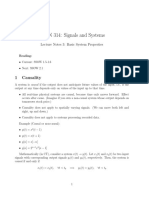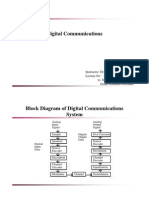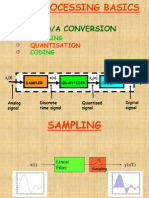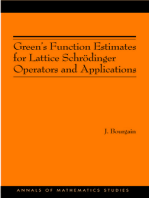Signals and Systems Formulas
Signals and Systems Formulas
Uploaded by
KPRBTCopyright:
Available Formats
Signals and Systems Formulas
Signals and Systems Formulas
Uploaded by
KPRBTCopyright
Available Formats
Share this document
Did you find this document useful?
Is this content inappropriate?
Copyright:
Available Formats
Signals and Systems Formulas
Signals and Systems Formulas
Uploaded by
KPRBTCopyright:
Available Formats
Summary 1: Overview of Signals and Systems
A. Signals:
Unit impulse function: ( ) t
0, 0
( )
, 0
t
t
t
=
=
, ( ) 1 t dt
0 0
( ) ( ) ( ) t t f t dt f t
Unit step function: ( ) u t
1, 0
( )
0, 0
t
u t
t
>
=
<
0
( )
( ), ( ) ( )
t
du t
t d u t
dt
= =
Unit ramp function:
0
, 0
( ) ( ) ( )
0, 0
t
t t
r t tu t u d
t
>
= = =
<
Sinusoidal function:
0 0 0
( ) cos(2 ), x t A f t = +
0
A =Amplitude
0
f =Frequency (Hz)
0
1/ T f = =Period (sec)
0
=Phase angle (rad)
Signum function:
1, 0
sgn( ) 2 ( ) 1
1, 0
t
t u t
t
>
= =
<
Rectangle function:
1, / 2 / 2
( ) ( ) ( )
2 2
0, | | / 2
T t T
t T T
rect u t u t
T
t T
< <
= + =
>
Unit triangle function:
1 | |, 1 1
( )
0, | | 1
t t
tri t
t
< <
=
>
Unit sinc function:
sin( )
sin ( )
t
c t
t
=
Unit comb function: ( ) ( ),
n
comb t t n n
=
=
an integer
B. Properties of Systems:
Linearity: a system is said to be linear such that if
1 1
2 2
( ) ( )
( ) ( )
x t y t
x t y t
then
1 2 1 2
( ) ( ) ( ) ( ) ax t bx t ay t by t + + ; a and b are arbitrary constants
The property
1 1
( ) ( ) ax t ay t is referred to as homogeneity, and
the property
1 2 1 2
( ) ( ) ( ) ( ) x t x t y t y t + + is referred to as additivity
Time Invariance: a system is said to be time-invariant such that if
( ) ( ) x t y t
then
0 0
( ) ( ) x t t y t t ;
0
t is an arbitrary time-shift
Causality: a system is said to be causal if the output signal does not
depend on the future values of the input signal. Non-causal systems are
not realizable. For causal systems, if
0
( ) 0, x t for t t = <
then
0
( ) 0, y t for t t = <
Memory: a system is said to be memory-less if at any moment of time
the output depends on the input at that moment. A resistive circuit is a
memory-less system, whereas a circuit with capacitors and/or inductors
has memory.
Invertibility: a system is said to be invertible if unique inputs produce
unique outputs; that is, different inputs do not produce the same output
and one input does not produce different outputs.
Stability: a system is said to be (bounded input-bounded output or
BIBO) stable if bounded inputs result in bounded outputs.
System Input, x(t) y(t), Output
C. Convolution
Definition:
1 2 1 2
( )* ( ) ( ) ( ) f t f t f f t d
, convolution of
1
( ) f t and
2
( ) f t
For linear time-invariant (LTI) systems, the output response is the
convolution of the input signal ( ) x t and the impulse response ( ) h t ,
0 0
( ) ( )* ( ) ( ) ( ) ( ) ( )
t t
y t x t h t h x t d h t x d = = =
Properties of Convolution:
-
1 2 2 1
( )* ( ) ( )* ( ) f t f t f t f t =
-
1 2 3 1 2 1 3
( )*[ ( ) ( )] ( )* ( ) ( )* ( ) f t f t f t f t f t f t f t + = +
-
1 2 3 1 2 3
[ ( )* ( )]* ( ) ( )*[ ( )* ( )] f t f t f t f t f t f t =
If ( ) ( )* ( ) y t x t h t = , then
-
0 0 0
( ) ( )* ( ) ( ) ( ) y t t x t h t t x t t h t = =
-
( ) ( ) ( )
* ( ) ( )*
dy t dx t dh t
h t x t
dt dt dt
= = , assuming the derivatives exist
- ( ) [ ( ) ]* ( ) ( )*[ ( ) ]
t t t
y d x d h t x t h d
= =
- ( )* ( ) ( ) x t t x t =
-
0 0
( )* ( ) ( ) x t t t x t t =
Steady-State Response of LTI Systems to sinusoidal inputs:
If
0 0 0
( ) cos(2 ) x t A f t = + ,
0 0 0 0 0
( ) | ( )|cos[2 ( )]
ss
y t A H f f t H f = + + , steady-state response
If the system is represented by an electric circuit, the system function H(f)
is obtained by solving the circuit in the frequency domain using the trans-
formations , , 1/ ; 2 R R L j L C j C f = .
H(f) x(t) y(t)
You might also like
- First Periodical Test in Mathematics 8Document7 pagesFirst Periodical Test in Mathematics 8Raisa Sontillano92% (77)
- Continuous and Discrete Time Signals and Systems (Mandal & Asif) Solutions - Chap02Document36 pagesContinuous and Discrete Time Signals and Systems (Mandal & Asif) Solutions - Chap02Lyubomir Hristov91% (11)
- RespuestasDocument18 pagesRespuestasAndres HerediaNo ratings yet
- UNSW ENGG1000 Final Report Criteria 2014Document6 pagesUNSW ENGG1000 Final Report Criteria 2014KukurooNo ratings yet
- Linear System Theory and Design: Taesam KangDocument42 pagesLinear System Theory and Design: Taesam KangFiriceNguyenNo ratings yet
- Dynamic Characteristics: Input Signal X (T) Output Signal y (T)Document29 pagesDynamic Characteristics: Input Signal X (T) Output Signal y (T)veenadivyakishNo ratings yet
- Sas SeriesDocument8 pagesSas SerieskganesharunNo ratings yet
- Dynamic Charactorstics of An InstrumentsDocument30 pagesDynamic Charactorstics of An InstrumentsDhinakaran VeemanNo ratings yet
- Exercises For Signals and Systems (Part Four)Document3 pagesExercises For Signals and Systems (Part Four)Vincent YuchiNo ratings yet
- KOM 3781 Discrete-Time Control Systems: Veysel GaziDocument38 pagesKOM 3781 Discrete-Time Control Systems: Veysel GaziFatih CanbolatNo ratings yet
- ECE 414 Tutorial 1: Review: Random Process Fourier Transform OuetasoDocument16 pagesECE 414 Tutorial 1: Review: Random Process Fourier Transform OuetasosaiknaramNo ratings yet
- Ufabccapitulo 1Document121 pagesUfabccapitulo 1Leonardo De Avellar FredericoNo ratings yet
- Control Systems: Dynamic ResponseDocument35 pagesControl Systems: Dynamic ResponseLovemore MakombeNo ratings yet
- Chapter 3 - MatlabDocument59 pagesChapter 3 - MatlabZe SaNo ratings yet
- System PrototypesDocument29 pagesSystem PrototypesYgor AguiarNo ratings yet
- Serv - Chula.ac - TH Tarporn 487 HandOut DynamicCDocument38 pagesServ - Chula.ac - TH Tarporn 487 HandOut DynamicCAaditya RoyNo ratings yet
- Time-Continous Stochastic Processes 0. Time Continous Stochastic ProcessesDocument10 pagesTime-Continous Stochastic Processes 0. Time Continous Stochastic ProcessesHuy DuNo ratings yet
- EECS3451 Chapter2Document24 pagesEECS3451 Chapter2nickbekiaris05No ratings yet
- Ece2610 Chap9Document24 pagesEce2610 Chap9Bayar JargalNo ratings yet
- Band Pass Systems, Phasors and Complex Representation of SystemsDocument23 pagesBand Pass Systems, Phasors and Complex Representation of Systemsamitranjan_77No ratings yet
- Continuous-Time Systems: Dept. of Electrical and Computer Engineering The University of Texas at AustinDocument24 pagesContinuous-Time Systems: Dept. of Electrical and Computer Engineering The University of Texas at AustinIr Wn IkaarinaNo ratings yet
- Table of Fourier Transform PairsDocument8 pagesTable of Fourier Transform PairsmayankfirstNo ratings yet
- Signals & SystemsDocument55 pagesSignals & SystemsWaqas Akram GondalNo ratings yet
- DSP-Lec 2Document28 pagesDSP-Lec 2ngmaherNo ratings yet
- Communication IITN Review1Document28 pagesCommunication IITN Review1Pankaj MeenaNo ratings yet
- Added Slides For Chapter2Document24 pagesAdded Slides For Chapter2Minh Huệ TôNo ratings yet
- The Convolution Integral: D T H X T H T X T yDocument39 pagesThe Convolution Integral: D T H X T H T X T yshahriaraustNo ratings yet
- LT I Differential Equations: y (T) L (Y (S) ) C(S) R(S) G(S) Q(S) R(S) C(S) Initial Condition PolynomialDocument8 pagesLT I Differential Equations: y (T) L (Y (S) ) C(S) R(S) G(S) Q(S) R(S) C(S) Initial Condition Polynomialbob3173No ratings yet
- EL-4701 Modelos de Sistemas: FormularioDocument9 pagesEL-4701 Modelos de Sistemas: FormularioEmmanuel AcostaNo ratings yet
- MIT6 003S10 Lec04 PDFDocument62 pagesMIT6 003S10 Lec04 PDFThắng PyNo ratings yet
- Ss QuetionsDocument7 pagesSs QuetionsSalai Kishwar JahanNo ratings yet
- ELEG 3124 Assignment # 1Document16 pagesELEG 3124 Assignment # 1Nguyễn Văn ĐứcNo ratings yet
- Eee2035F Exam Signals and Systems I: University of Cape Town Department of Electrical EngineeringDocument3 pagesEee2035F Exam Signals and Systems I: University of Cape Town Department of Electrical EngineeringRubia IftikharNo ratings yet
- Stationary Random ProcessesDocument62 pagesStationary Random ProcessesGramoz CubreliNo ratings yet
- Analysis of LTI-Systems: 3.1 Initial ResponseDocument97 pagesAnalysis of LTI-Systems: 3.1 Initial ResponseSergio LinNo ratings yet
- Uraian FourierDocument91 pagesUraian FourierAgus Dian PratamaNo ratings yet
- Modern Control Lec2Document19 pagesModern Control Lec2Saad FaruquiNo ratings yet
- Peretmuan 12 Laplace in CircuitsDocument56 pagesPeretmuan 12 Laplace in CircuitsSando CrisiasaNo ratings yet
- Assignment For Signal AnalysisDocument2 pagesAssignment For Signal AnalysisAhmed EwadaNo ratings yet
- ECEN 314: Signals and Systems: 1 CausalityDocument4 pagesECEN 314: Signals and Systems: 1 CausalityMafer ValdezNo ratings yet
- 2019 Answers PDFDocument56 pages2019 Answers PDFNitya Pooja ReddyNo ratings yet
- ECEN 314: Signals and Systems: 1 CausalityDocument4 pagesECEN 314: Signals and Systems: 1 CausalityMEIVELJ 19EE025No ratings yet
- General Forced ResponseDocument21 pagesGeneral Forced ResponsekalpanaadhiNo ratings yet
- Lecture 04 - Signal Space Approach and Gram Schmidt ProcedureDocument20 pagesLecture 04 - Signal Space Approach and Gram Schmidt ProcedureKhoa PhamNo ratings yet
- Review 1Document30 pagesReview 1mohammed dowNo ratings yet
- ESE242 Chapter 2Document12 pagesESE242 Chapter 2olivefieraNo ratings yet
- EEE2035F: Signals and Systems I: Class Test 1Document5 pagesEEE2035F: Signals and Systems I: Class Test 1sanjayb1976gmailcomNo ratings yet
- 2019.02.04 L06 S&S Systems PropertiesDocument24 pages2019.02.04 L06 S&S Systems PropertiesbilalNo ratings yet
- ECE633 Signals and Systems I, Fall 2009 - Homework 2 SolutionsDocument13 pagesECE633 Signals and Systems I, Fall 2009 - Homework 2 SolutionsGabrielPopoola13100% (2)
- Signals and Systems 01Document10 pagesSignals and Systems 01nvbondNo ratings yet
- ELCE301 Lecture5 (LTIsystems Time2)Document31 pagesELCE301 Lecture5 (LTIsystems Time2)Little VoiceNo ratings yet
- 2.160 Identification, Estimation, and Learning Lecture Notes No. 1Document7 pages2.160 Identification, Estimation, and Learning Lecture Notes No. 1Cristóbal Eduardo Carreño MosqueiraNo ratings yet
- Signal & Systems - EE 221 - A-1Document6 pagesSignal & Systems - EE 221 - A-1Piyush OjhaNo ratings yet
- Lecture 18 - Summary of The Course Preparations For Final ExaminationDocument19 pagesLecture 18 - Summary of The Course Preparations For Final ExaminationEdutamNo ratings yet
- Sampling TheoremDocument34 pagesSampling Theoremgaurav_juneja_4No ratings yet
- Green's Function Estimates for Lattice Schrödinger Operators and ApplicationsFrom EverandGreen's Function Estimates for Lattice Schrödinger Operators and ApplicationsNo ratings yet
- The Spectral Theory of Toeplitz Operators. (AM-99), Volume 99From EverandThe Spectral Theory of Toeplitz Operators. (AM-99), Volume 99No ratings yet
- Inverse Trigonometric Functions (Trigonometry) Mathematics Question BankFrom EverandInverse Trigonometric Functions (Trigonometry) Mathematics Question BankNo ratings yet
- Eca Lab IntroductionDocument7 pagesEca Lab IntroductionbharathjreddyNo ratings yet
- User Guide Incompact3d V1-0Document8 pagesUser Guide Incompact3d V1-0Danielle HaysNo ratings yet
- BFC21103 Chapter2Document74 pagesBFC21103 Chapter2amirah100% (1)
- Lab Manual # 08: Title: Arrays in C++ One D ArrayDocument18 pagesLab Manual # 08: Title: Arrays in C++ One D ArrayUsama SagharNo ratings yet
- Eigenvalues PDFDocument1 pageEigenvalues PDFcaleb castilloNo ratings yet
- AutoCAD ppt-5 AutoCAD Three-Dimensional DrawingDocument21 pagesAutoCAD ppt-5 AutoCAD Three-Dimensional DrawingBereket ArayaNo ratings yet
- MFCC CodeDocument8 pagesMFCC Codesateesh83No ratings yet
- The Nature of CognitionDocument730 pagesThe Nature of Cognitiondaniel gatyoNo ratings yet
- Scipy RefDocument935 pagesScipy RefSugan RajNo ratings yet
- Introduction To BondsDocument5 pagesIntroduction To BondsHuu Duy100% (1)
- C211 - Operating Systems Tutorial: Scheduling - AnswersDocument2 pagesC211 - Operating Systems Tutorial: Scheduling - Answerssally D.allahNo ratings yet
- Physics Spectrum - PsDocument46 pagesPhysics Spectrum - PsiitforumNo ratings yet
- Curriculum 2016-2017 Materials CegepDocument2 pagesCurriculum 2016-2017 Materials CegepMai RoblesNo ratings yet
- 11h Physics Unit 1 Model Question Paper English Medium PDFDocument3 pages11h Physics Unit 1 Model Question Paper English Medium PDFMohana UM100% (1)
- 10-Analysis of Beam Foundation-En-Part IIIDocument45 pages10-Analysis of Beam Foundation-En-Part IIIMahmoud El GendyNo ratings yet
- Signal Flow Graphs LectureDocument41 pagesSignal Flow Graphs Lecturedanish azharNo ratings yet
- WstyophDocument28 pagesWstyophjskskkNo ratings yet
- How To Calculate Overall Equipment Effectiveness: A Practical GuideDocument8 pagesHow To Calculate Overall Equipment Effectiveness: A Practical GuideKumarNo ratings yet
- Peka Science 2Document6 pagesPeka Science 2Eli ZahNo ratings yet
- Module Number 6 Instructional Planning ModelsDocument7 pagesModule Number 6 Instructional Planning ModelsKZR BautistaNo ratings yet
- Thorp - What I Knew and When I Knew ItDocument11 pagesThorp - What I Knew and When I Knew ItTobias Bogner100% (1)
- PATENT APPLICATION: CRAFT USING AN INERTIAL MASS REDUCTION DEVICE (Anti-Gravity)Document7 pagesPATENT APPLICATION: CRAFT USING AN INERTIAL MASS REDUCTION DEVICE (Anti-Gravity)David SilveyNo ratings yet
- Set Theory: Prepared By: Victor A. Estalilla JRDocument127 pagesSet Theory: Prepared By: Victor A. Estalilla JRfreshynNo ratings yet
- Feb 7 Homework Solutions Math 151, Winter 2012 Chapter 4 Problems (Pages 172-179)Document8 pagesFeb 7 Homework Solutions Math 151, Winter 2012 Chapter 4 Problems (Pages 172-179)Pei JingNo ratings yet
- Multicriteria Decision Making: Timothy Havranek, Doug MacnairDocument242 pagesMulticriteria Decision Making: Timothy Havranek, Doug Macnairnormando vikingoNo ratings yet
- International Journal of Fatigue: A. Cruzado, S.B. Leen, M.A. Urchegui, X. GómezDocument15 pagesInternational Journal of Fatigue: A. Cruzado, S.B. Leen, M.A. Urchegui, X. GómezAli Cherif MessellekNo ratings yet
- Nlogit An R Package PresentationDocument40 pagesNlogit An R Package Presentationatom108No ratings yet
- 03 Meshing MethodsDocument51 pages03 Meshing MethodsPatNo ratings yet

























































































